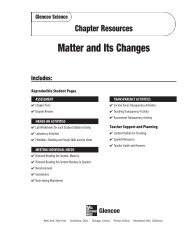Atoms, Elements, and the Periodic Table - Learning Services Home
Atoms, Elements, and the Periodic Table - Learning Services Home
Atoms, Elements, and the Periodic Table - Learning Services Home
You also want an ePaper? Increase the reach of your titles
YUMPU automatically turns print PDFs into web optimized ePapers that Google loves.
Name Date ClassDirected Reading forContent MasterySection 2 ■ The Simplest MatterSection 3 ■ Compounds <strong>and</strong>MixturesDirections: Circle <strong>the</strong> two terms in each group that are related. Then explain why <strong>the</strong> terms are related.1. copper, iron, salt2. air, milk, waterCopyright © Glencoe/McGraw-Hill, a division of <strong>the</strong> McGraw-Hill Companies, Inc.3. protons, neutrons, mixtures4. mixture, isotope, compoundDirections: Circle <strong>the</strong> term that correctly completes <strong>the</strong> sentence.5. The number of protons in an atom determines its (atomic number/nucleus).6. An element’s (atomic mass/mass number) is an average mass of <strong>the</strong> differentisotopes of <strong>the</strong> element.7. A(n) (compound/element) is matter that is made up of only one kind of atom.8. (Mixtures/Isotopes) are atoms of <strong>the</strong> same element with different numbers ofneutrons.9. (Metals/Metalloids) are <strong>the</strong> best conductors of heat <strong>and</strong> electricity.10. All <strong>the</strong> metals except mercury are (solid/liquid) at room temperature.11. A(n) (compound/element) is a substance whose smallest unit is made up ofmore than one element.12. Matter that has <strong>the</strong> same composition <strong>and</strong> properties throughout is called a(n)(substance/isotope).Meeting Individual Needs<strong>Atoms</strong>, <strong>Elements</strong>, <strong>and</strong> <strong>the</strong> <strong>Periodic</strong> <strong>Table</strong> 17














